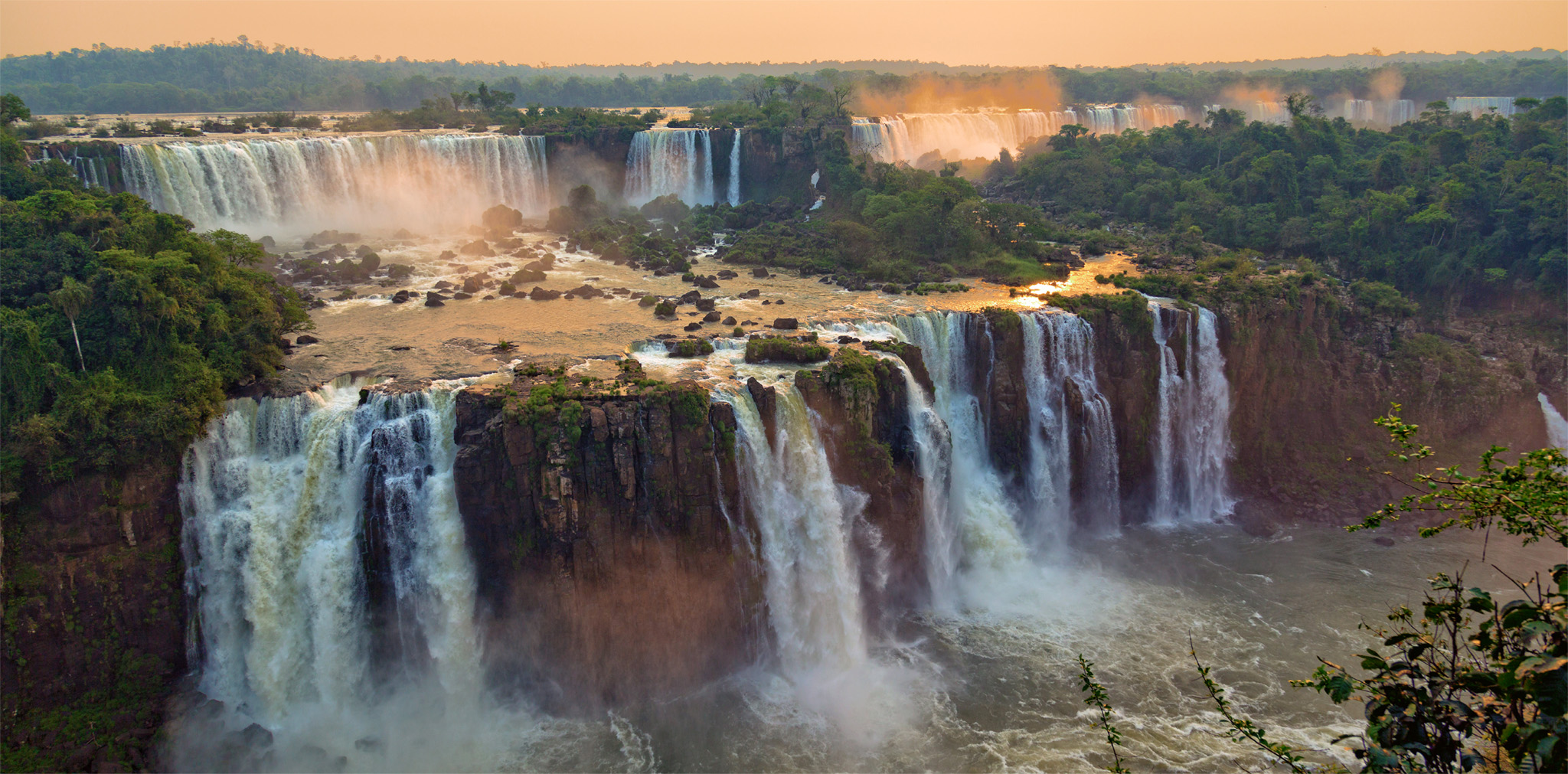
t The tumbling falls
Before these mighty waterfalls even come into view, their rumbling roar and great clouds of spray hint at the spectacle about to unfold. Drenching the surrounding tropical forest, the Iguaçu Falls cascade over blood-red rocks and hurtle down the wide river canyon in an awesome display of the power of nature.

t The tumbling falls
Experience Santa Catarina and Paraná
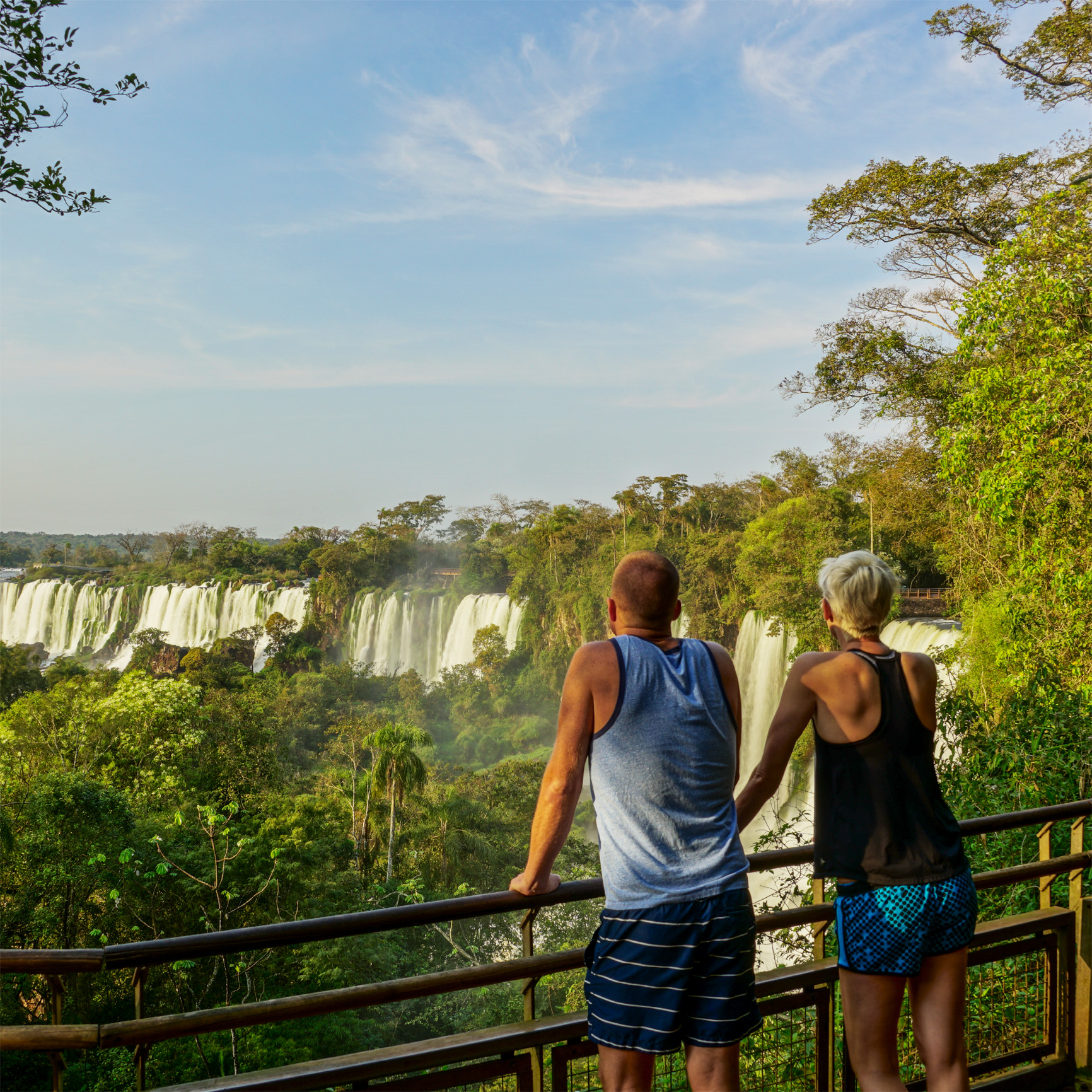
t Which draw visitors for their spectacular views
The Iguaçu Falls rate as one of South America’s great natural sights. The falls are formed by a succession of 275 interlinking cataracts up to 246 ft (75 m) in height cascading over a 1.8-mile- (3-km-) wide precipice. The falls owe their origins to several successive volcanic layers of rock built up over 110 million years. Shared between Brazil and Argentina, they are completely surrounded by nature preserves. The two preserves of Brazil’s Parque Nacional do Iguaçu and Argentina’s Parque Nacional Iguazú contain one of the largest surviving tracts of Atlantic forest in South America. Both national parks are also abundant with wildlife (including jaguar and harpy eagle) and offer sweeping views of the falls, as well as options to go closer to the cascades by boat.
The falls are located near the Brazilian city of Foz do Iguaçu and the sleepy Argentinian town of Puerto Iguazú. This majestic area has excellent access roads and tourist facilities; the Brazilian national park is also home to the highly acclaimed Hotel das Cataratascan. The Iguaçu region, meaning “Great Waters” in Tupí-Guaraní, was declared a UNESCO World Heritage Site in 1986.
Experience Santa Catarina and Paraná
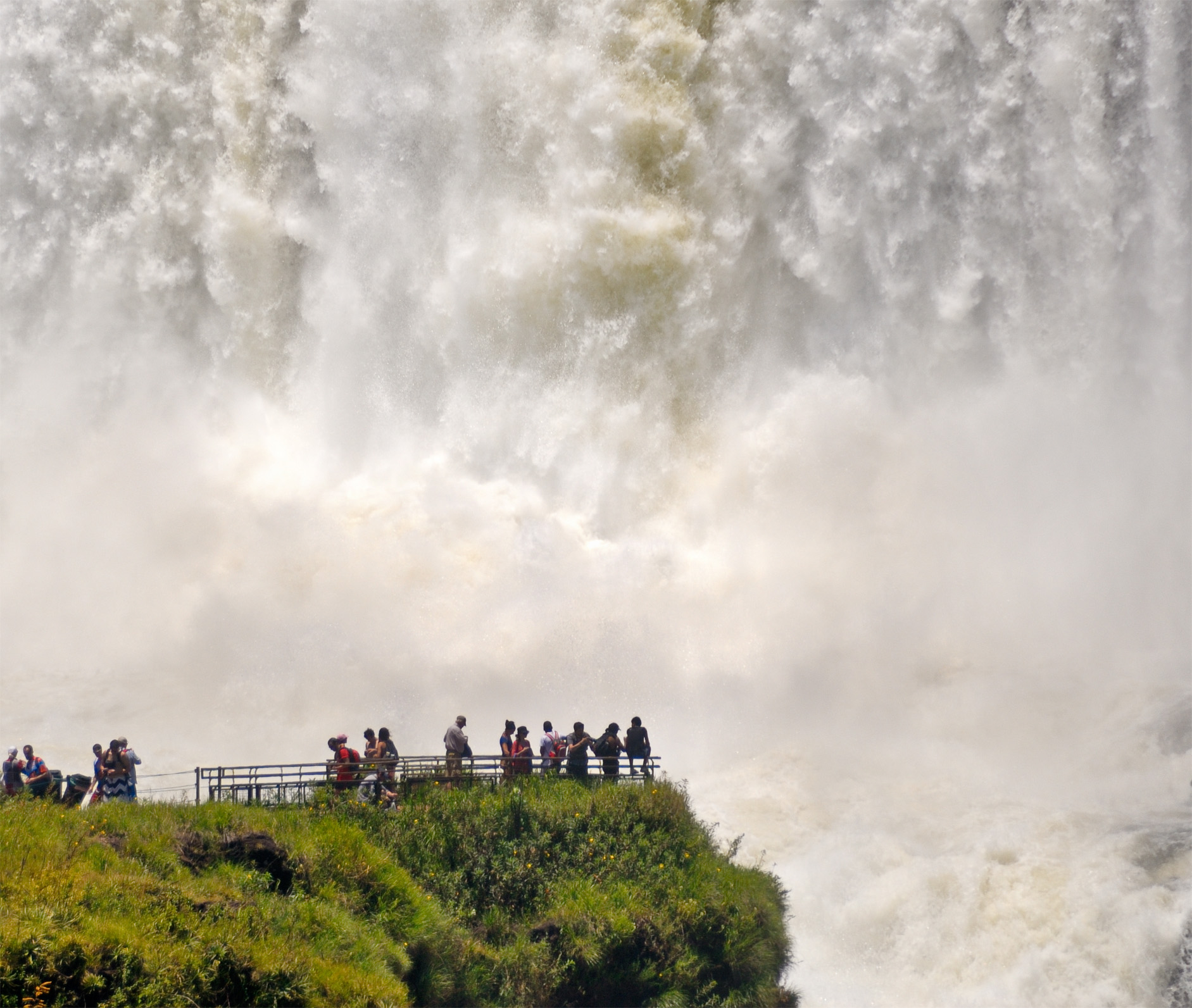
Although the Brazilian side is best for panoramic views, it is easier to get closer to the main cataracts from the trails on the Argentinian side. The forest preserve here is larger than the Brazilian one, with good walkable trails, requiring time to explore. There is also a greater likelihood of spotting some of the area’s exotic wildlife on the Argentinian side. Local buses travel from Brazil to Argentina; get off at the immigration borders on both sides to get your passport stamped.
Experience Santa Catarina and Paraná
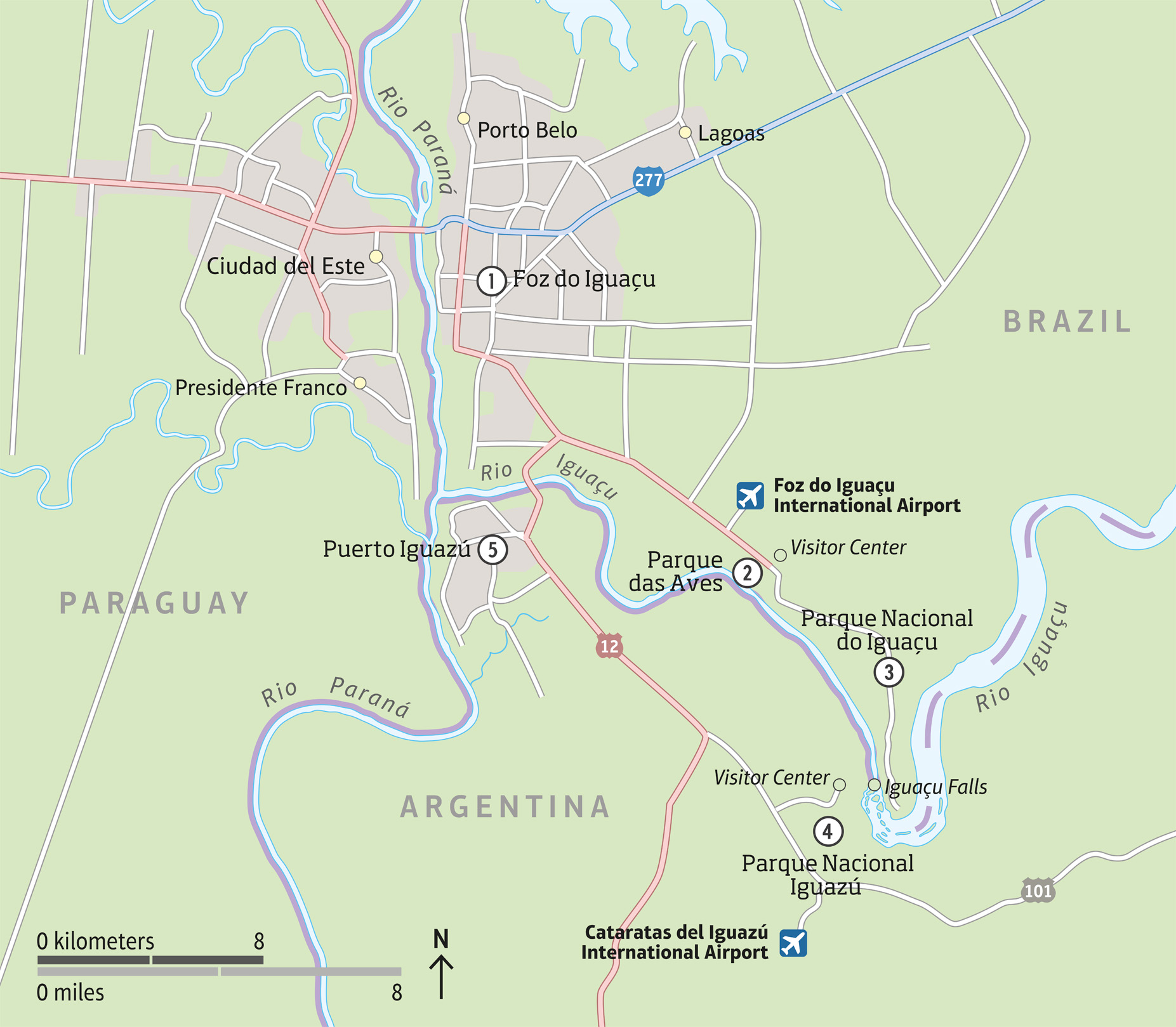
n Double-tap image to read the labels
Foz do Iguaçu, also referred to just as Foz, was a sleepy little border town until the 1970s, when construction work began on the nearby Itaipu Binacional, the world’s largest hydroelectricity plant. Today, Foz is an excellent base from which to visit the city’s main attraction, the spectacular waterfalls located to the east. The pleasant border town also offers a wide range of accommodations, as well as reasonably good bars and restaurants.
Located close to the main entrance of the Parque Nacional do Iguaçu, the Parque das Aves serves as an introduction to Brazilian birdlife. The park has large aviaries housing some 1,400 birds of 140 species from different ecosystems, which include macaws, toucans, red-winged tinamous, and flamingos. The park also has a butterfly habitat, reptile exhibit, and a successful breeding program that focuses on Brazilian endangered species.
The extent of native flora and fauna that the parks offer is varied. Over 2,000 species of flora have been identified, and the region serves as a habitat for a similarly varied range of wildlife, lured by fruit, nesting spots, and dens. There are 450 varieties of bird amid this forested area, which can be best spotted early in the morning and at dusk, when toucans, parrots, and hummingbirds abound. Some 80 kinds of mammals, with five varieties of feline, also rove the forest. Early morning and evening are the best time to see animals, with monkeys sometimes seen swinging overhead through the forest’s canopy. The most commonly sighted mammal is the coati.
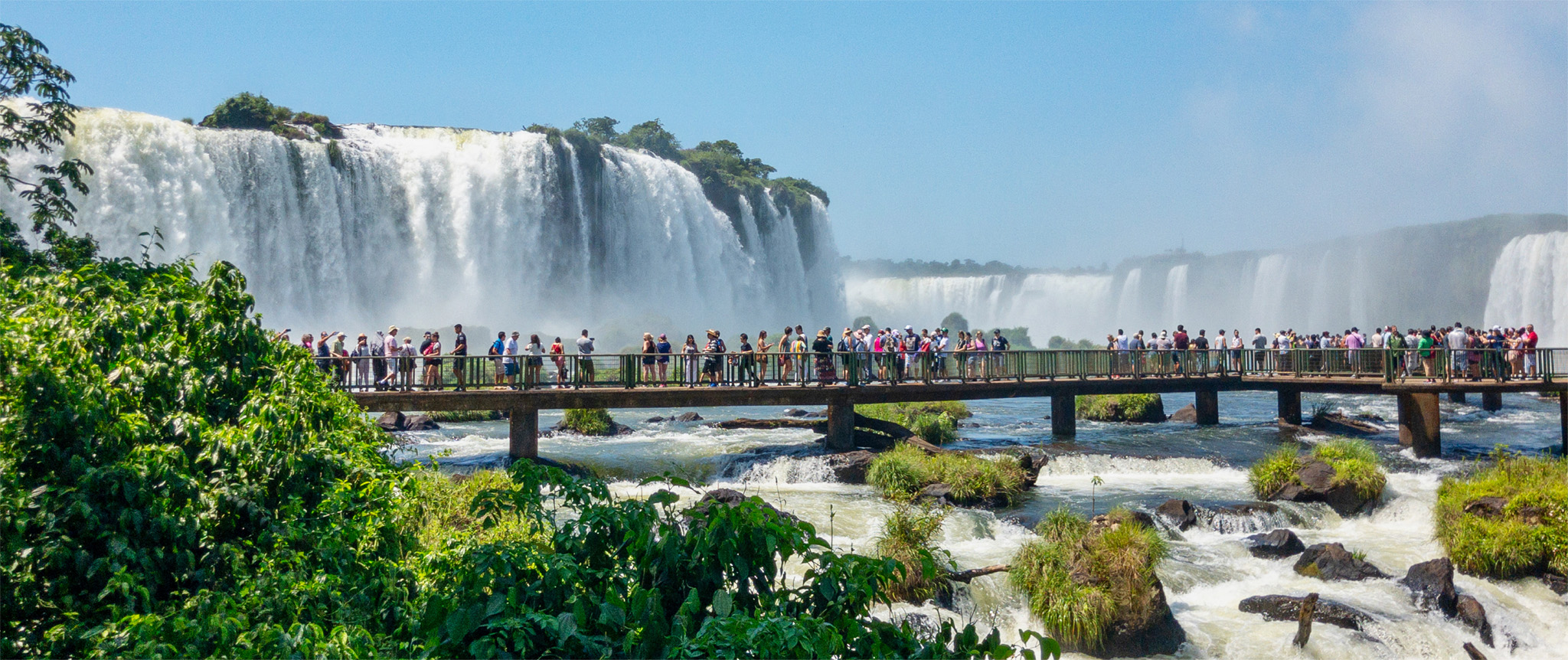
t Visitors lining a bridge within the Parque Nacional do Iguaçu
Created in 1939, Brazil’s second-oldest national park is today one of the most visited sights in the country. Public and tour buses leave visitors at the visitors’ center near the park’s entrance where they transfer onto electric-powered, open-topped buses for the falls, located 6 miles (10 km) into the park. The bus stops at the Estação Macuco Safari, where a smaller vehicle can (for an additional charge) take visitors along a forest trail to the Rio Iguaçu. There, inflatable powerboats carry visitors across rapids toward the Garganta do Diabo (Devil’s Throat) and to virtually the foot of the falls. Along the way are various rest points with spectacular panoramic views of the main series of falls. At the trail’s lowest point there is a secure walkway that leads to a platform where one can peer into the stunning Garganta do Diabo, a deep gorge into which the fierce, cascading waters of the falls plummet.
Where the Brazilian park’s great attractions are the spectacular panoramic views of the falls, the Argentinian park has an extensive network of forest and waterside trails, which offer visitors close-up views of the smaller falls. As well as the Garganta del Diablo trail, there are routes called the Paseo Inferior and the Paseo Superior. From the visitors’ center, a miniature railroad leads to the Estación Central where the Paseo Inferior and Paseo Superior circuits begin. From the Paseo Superior, visitors can look down onto and across dozens of cataracts. This circuit has concrete catwalks going behind the falls, while the Paseo Inferior is shorter, offering even more breathtaking views of the falls from below. Especially remarkable are the parts of the trail across catwalks allowing amazing views over cascading water. At the lowest point, boats make the short crossing to the Isla San Martín, an island located in the heart of the falls. Walking here requires a high level of fitness, as it involves clambering up steep slopes and across some jagged rock formations.
Traveling between Foz and the Argentinian park by public transport involves changing buses in Puerto Iguazú, Argentina’s most north-eastern city. Although Puerto Iguazú has few sights of note, its quiet, tree-lined streets make for attractive wandering, with wooden, rather than concrete, buildings predominating.
A short walk along Puerto Iguazú’s main artery, Avenida Victoria Aguirre, leads to the Hito Tres Fronteras (Triple Borders Landmark). From here there are beautiful views of the Iguaçu and Paraná rivers and across the rivers to Brazil and Paraguay.